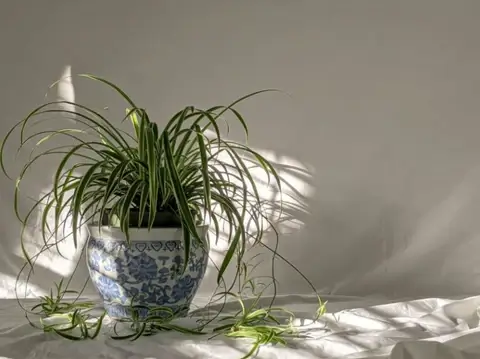Spider plants (Chlorophytum comosum) have earned a top spot in the world of indoor gardening and for good reason. Their graceful arching leaves, low maintenance needs, and air-purifying qualities make them a favorite for both beginners and seasoned plant lovers.
But if you live in a space with limited sunlight (like an apartment, office corner, or basement room) you may wonder: Can spider plants live in low light?
The short answer is yes, but with some limitations. Spider plants can adapt to low-light spaces if you follow the right care strategies.
In this guide, we’ll cover:
- What qualifies as “low light”
- How spider plants behave in dim conditions
- Benefits and drawbacks of low-light placement
- Best care practices for healthy growth
- Common mistakes to avoid
- Varieties that perform well in shade
What Does “Low Light” Actually Mean?
Before placing your spider plant in a shadowy corner, it’s important to define what “low light” means. In plant care, low light doesn’t mean no light.
Low light typically refers to areas where:
- There is indirect sunlight several feet away from a window
- Artificial lighting (LED or fluorescent bulbs) provides the main source of light
- Sunlight is blocked or diffused by curtains, walls, or furniture
Examples of Low-Light Spots Indoors
- Bathrooms with small frosted windows
- Bedrooms with north-facing windows
- Offices with only overhead lights
Important: Total darkness or windowless rooms without artificial light are not suitable for spider plants.
Can Spider Plants Survive in Low Light?
Yes, spider plants can survive in low light. They are adaptable compared to many houseplants. However, survival and thriving are not the same.
In low-light spaces, spider plants may:
- Grow more slowly
- Develop pale or dull leaves
- Produce fewer “baby” spiderettes
- Become leggy or stretched out
If you are comfortable with slower growth and give them a little extra care, they will do just fine indoors.
Why Are Spider Plants a Good Choice for Low-Light Rooms?
1. Natural Shade Tolerance
In the wild, spider plants grow under taller vegetation, where light is filtered. This makes them naturally suited for dim indoor spaces.
2. Easy Maintenance
They don’t demand daily attention. As long as you avoid overwatering and keep them out of complete darkness, they’ll continue growing.
3. Air-Purifying Power
According to NASA’s Clean Air Study, spider plants can help filter indoor air. They remove pollutants like carbon monoxide and formaldehyde, making them a smart choice for health-conscious homes. You can also explore other air-purifying options in this guide: Indoor plants that clean the air.
Best Practices for Growing Spider Plants in Low Light
| Care Factor | Low-Light Adjustment |
|---|---|
| Light Placement | Keep within 3–6 feet of a window or under LED grow lights |
| Watering | Water less often; soil dries slowly in dim rooms |
| Cleaning Leaves | Wipe leaves every few weeks to remove dust |
| Rotation | Rotate pot weekly to avoid lopsided growth |
| Artificial Lighting | Provide 8–10 hours of LED grow light if natural light is minimal |
What to Watch Out For in Low Light
- Yellow or Pale Leaves: May indicate too little light or overwatering.
- Very Slow Growth: Common in low-light areas, but extreme stunting means more light is needed.
- Lack of Spiderettes: Low light often reduces baby plant production, as the plant conserves energy.
Best Spider Plant Varieties for Low Light
- Chlorophytum comosum ‘Vittatum’ – The classic green leaves with white stripes, very adaptable.
- Chlorophytum comosum ‘Bonnie’ – A curly-leaved variety, great for hanging baskets in shaded rooms.
Common Mistakes to Avoid in Low Light
- Keeping spider plants in complete darkness without artificial light
- Overwatering in dim rooms (soil dries much slower)
- Ignoring dust on leaves, which blocks the little light they get
- Expecting fast growth and many offshoots in low-light settings
FAQs
Can I keep a spider plant in a bathroom with no windows?
Yes, but only if you provide artificial light for several hours a day. For another bathroom-friendly plant, check out the Purple Heart Plant.
How long can spider plants survive in low light?
They can live indefinitely in low light if watered carefully and given occasional artificial light. For faster growth, supplement with LED lighting or try an indoor greenhouse.
Will my spider plant produce spiderettes in dim spaces?
Not usually. They’re more likely to grow baby plants in brighter indirect light.
Are spider plants safe for children and pets?
Yes, spider plants are non-toxic, but mild stomach upset may occur if eaten. Learn more here: Spider plant safety for children and Spider plants and cats.
Conclusion
Spider plants are one of the most forgiving indoor plants, and they adapt surprisingly well to low-light environments. While they won’t grow as fast or produce as many spiderettes, they will remain healthy, decorative, and air-purifying companions.
To succeed with spider plants in low light:
- Keep them within reach of indirect or artificial light
- Avoid overwatering
- Rotate regularly for balanced growth
- Clean leaves to maximize light absorption
Whether you’re a plant beginner or an experienced green thumb, the spider plant is a low-light hero worth adding to your collection. For more inspiration, explore our Top 50 indoor plants guide or discover the calming effects of lavender as an indoor plant.





